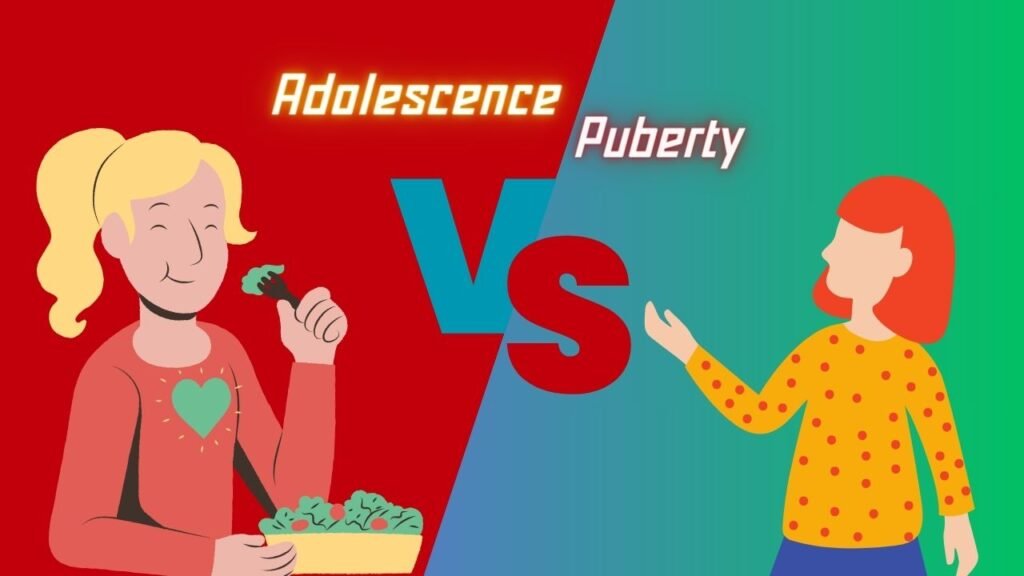5 Key Difference between Adolescence and Puberty PDF
Difference between Adolescence and Puberty: Adolescence it is a period in biological, psychological, sexual and social development, immediately after childhood and which begins with puberty. Its duration varies according to different sources and medical, scientific, and psychological opinions, but it generally begins between 10 and 12 years of age and ends at 19 to 20 years of age.
Adolescence is the transition period between childhood and adulthood. Adolescence covers a large part of the puberty period, but its boundaries are less defined, and it refers more to psychosocial and cultural characteristics.
During puberty, the process of physical changes takes place in which the body of the boy or girl becomes an adolescent, capable of sexual reproduction. During puberty, greater differences are noted in terms of size, shape, composition and functional development in many structures and systems of the body. Strictly speaking, the term “puberty” refers to the bodily changes of sexual maturation rather than the psychosocial and cultural changes that this entails.

Similarity between Adolescence and Puberty is Both are stages of change that lead to the social and emotional development of a person. Character and personality also develop in this stage. Here below we have describe similarity and Difference between Adolescence and Puberty in table and image format.
What is Adolescence?
Adolescence is a phase of maturation, it is a transitional period of humans physical and psychological development between childhood and adulthood. Typically it starts around the age of 11-12 and lasts until adulthood.
Biologically, adolescence is characterized by the onset of puberty with changes in the genitals. Height, weight, and muscle mass also change. Serious changes occur in the brain, its “maturation”. Adolescence is also characterized by improvements in abstract thinking, cognition, and logical reasoning.
Adolescence is considered as a stage of personality development, a process of transition from a dependent, supervised childhood, when a child lives according to special rules established for him by adults to an independent life.
What is Puberty?
Puberty is the process of changes in the body of a teenager, as a result of which he becomes an adult and capable of reproduction.
Puberty is a component of biological maturation. It is associated with the production of sex hormones in the body. In a girl’s puberty, the hormones estrogen, progesterone, FSH, and LH play a decisive role; boy – testosterone. The age at which puberty begins is different for all peers – this is normal. On average, girls’ puberty begins 1-2 years earlier than boys, so girls are sometimes taller and older in appearance, but this is temporary, after 1-2 years boys will catch up and surpass them.
In girls, puberty is characterized by the ability to conceive, bear a fetus, give birth, and raise offspring. In boys, the ability to fertilize. Puberty usually occurs earlier than the end of basic growth, structural and physiological, development of the body, before the onset of social and civil maturity.
Difference between Adolescence and Puberty
| Adolescence | Puberty |
|---|---|
| The period of life between childhood and adulthood. | A specific part of adolescence when the body starts to mature physically and sexually. |
| Typically starts around age 11-12 and lasts until adulthood. | Usually starts earlier, around age 9-10 for girls and 11-12 for boys, and lasts for a few years. |
| Involves significant physical, mental, and emotional changes, including complex thinking and stronger emotions. | Includes growth of body hair, development of reproductive organs, and other physical changes like growth spurts. Driven by hormones released by the brain and glands. |
| Covers overall journey from childhood to adulthood, involving many changes. | Focuses specifically on physical changes that turn a child’s body into an adult’s body. |
| It is completed in three stages early adolescence, middle adolescence, and late adolescence. | It is divided into three types central precocious puberty, peripheral precocious puberty and incomplete puberty. |
| It is achieved through practical apprehension and social maturity. | It is achieved with the help of hormones like testosterone in males and estrogen in females. |
| It is described in terms of psychological mental, and sexual maturity, and decision-making ability. | It is described in physiological terms like the growth of pubic hairs, hoarseness of voice in males, muscular growth, development of breasts, development of sweat and sebaceous glands, etc. |
5 Key Difference between Adolescence and Puberty PDF Image

FAQs on the Difference between Adolescence and Puberty
Q1. How does adolescence differ from puberty?
Answer: Adolescence in boys is the period of growing up when the body makes a sharp leap in its physical growth. This is the age at which puberty begins. Such changes inevitably affect the child’s behavior, his psychological and emotional state.
Q2. How is adolescence different from other periods of life?
Answer: Adolescence is characterized by the rapid growth and development of the entire organism. Intensive body growth is observed, ossification of the skeleton continues, and muscle strength increases. The control of the cerebral cortex over instincts and emotions improves. However, excitation processes still prevail over inhibition processes.
Q3. What is the difference between puberty and adolescence?
Answer: Adolescence begins with puberty and ends when these changes reach greater stability around age 19. Puberty marks the beginning of adolescence, which generally occurs between 10 and 13 years of age. The most obvious changes during this stage are physical.
Q4. What changes occur during puberty and adolescence?
Answer: Young adolescents (12 to 14 years old)
In most males, pubic and facial hair begins to appear, and their voice becomes deeper. In girls, pubic hair appears, breasts grow, and menstruation begins. These changes and the way others perceive them could be factors of concern for them.
